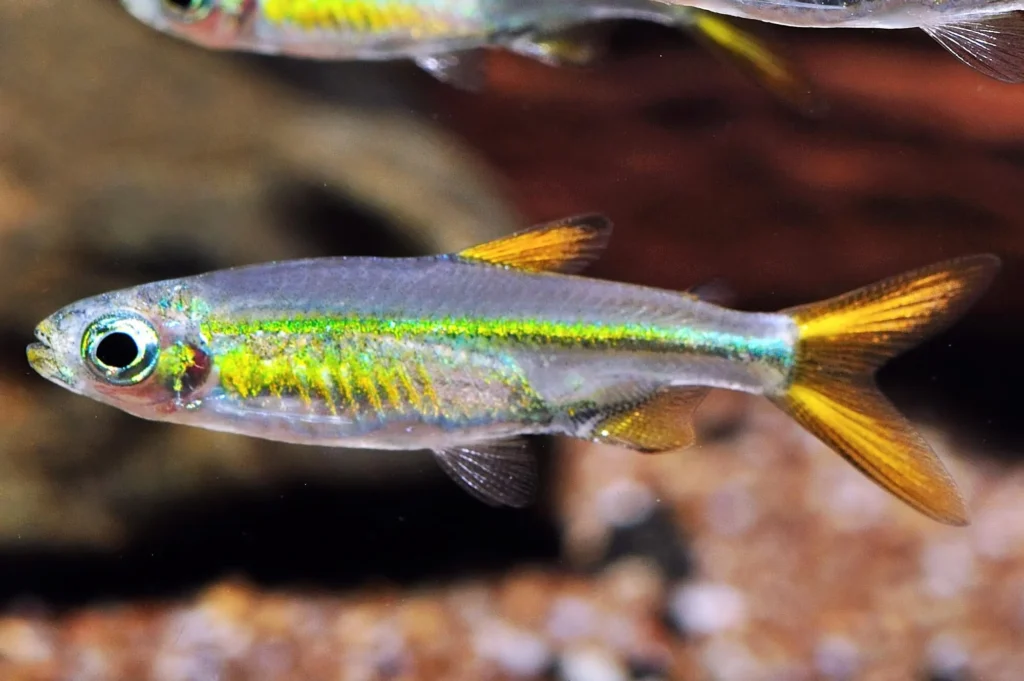
Size
Their maximum size is 3.1 cm.
Physical Characteristics and Behavior
This fish has a caudal fin that is forked and formed into an elongated, thin tetra. The dorsal and caudal fins have bands of yellow, and the dorsal fin is additionally tipped with black. The body is an iridescent silver color with hints of blue, and the fins are translucent. a timid, unassuming fish that peacefully shoals.
Keeping as a Pet

- Water Conditions
Sand, roots, and branches from driftwood would provide the ideal environment. In addition, water that is between 22 and 26 degrees Celsius and has a hardness of 5 to 10 degrees deg. is required.
- The Aquarium Size
Although smaller aquariums can be used for breeding, bases with minimum dimensions of 60*30 cm or equivalent are advised.
- Diet
Most likely a zooplankton-eating micropredator in the wild, preying on microscopic invertebrates. It will eat dried foods that are the right size in the aquarium, but it should also be given daily meals of small live and frozen foods like Artemia nauplii, Daphnia, Moina, grindal worm, etc.
- Behavior and Compatibility
Although it gets along well with other species, because of its small size and relatively specialized needs, it does not make the best communal fish. Lepidarchus adonis and Neolebias ansorgii, two other little tetras, as well as the majority of similarly sized, peaceful species that thrive in similar environments, including many smaller cyprinids, anabantoids, callicthyids, and loricariids, make good tankmates.
Many smaller cichlid species can also benefit from it as a companion, but in every case, careful investigation should be done before making a purchase. Since this species is sociable and the fish will behave more interestingly when kept in larger groups, try to purchase at least 8–10 specimens.
- Maintenance
Best kept in a well-organized setting that ideally includes a sandy substrate as well as some driftwood roots and branches. The addition of dried leaf litter emphasizes the natural feel even more and, in addition to providing more cover for the fish, encourages the development of microbial colonies as decomposition takes place. The tannins and other compounds generated by the decomposing leaves are also thought to be advantageous for fish from blackwater settings, making these a valuable secondary food source for fry. Cones made of alder can also be utilized for the latter objective.
It appears that this species thrives in rather low lighting. Aquatic plant species like Microsorum, Taxiphyllum, or Cryptocoryne spp. that can endure such circumstances can be added. Floating vegetation, particularly Ceratopteris spp., is also beneficial. A reverse osmosis unit or another method of obtaining soft water may be required for breeding purposes because acidic conditions with negligible carbonate hardness and very low general hardness are needed. If necessary, this soft water can be further acidified using phosphoric acid or a similar substance. There is no need to use natural peat, as its gathering harms the ecology and is not sustainable. It goes without saying that because of their sensitivity to changing organic waste levels, this species should never be added to aquariums with immature biological systems.
- Behavior and Compatibility
Although it gets along well with other species, due to its small size and relatively specialized requirements, it does not make the best communal fish. Lepidarchus adonis and Neolebias ansorgii, two other little tetras, as well as the majority of similarly sized, peaceful species that thrive in similar environments, including many smaller cyprinids, anabantoids, callicthyids, and loricariids, make good tankmates.
Many smaller cichlid species can also benefit from it as a companion, but in every case, careful investigation should be done before making a purchase. Since this species is sociable and the fish will behave more interestingly when kept in larger groups, try to purchase at least 8–10 specimens.
Table





